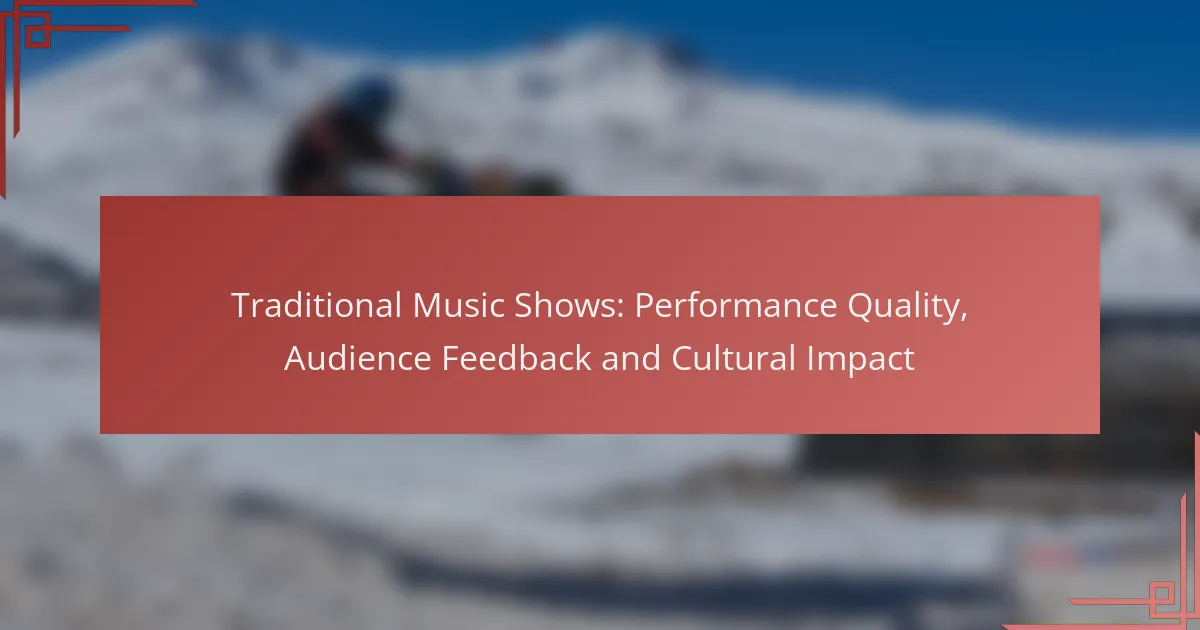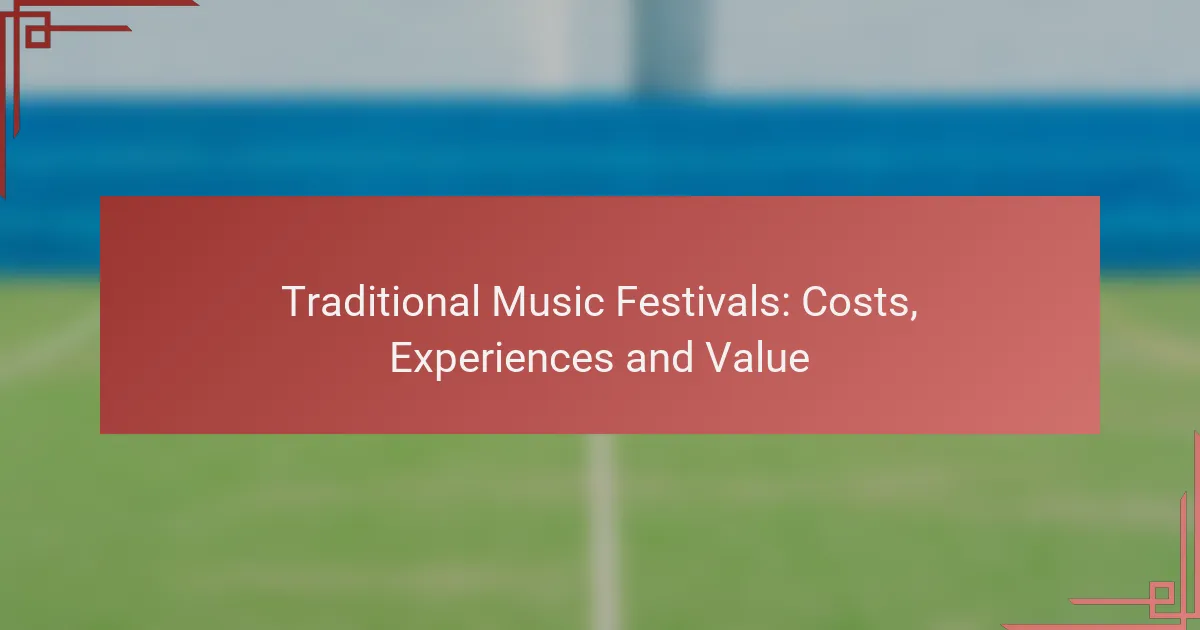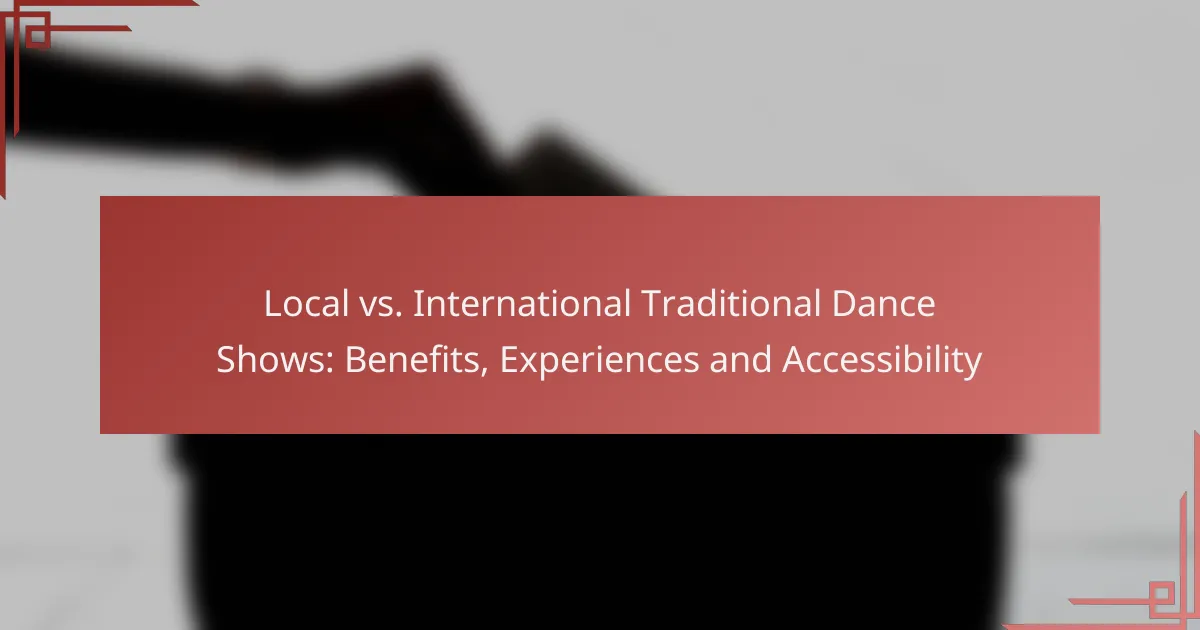Traditional music shows serve as vibrant expressions of cultural heritage, showcasing diverse performance styles and unique instruments that vary across different regions. These events not only highlight the artistic influences of each culture but also foster active audience engagement, creating emotional connections and a sense of community. Through participation and appreciation, audiences deepen their understanding of the cultural significance embedded in these performances.

How do traditional music shows vary across cultures?
Traditional music shows differ significantly across cultures, reflecting unique historical, social, and artistic influences. These variations can be seen in the styles of performance, instruments used, and the ways audiences engage with the music.
Regional styles in Africa
African traditional music shows are characterized by diverse regional styles, each with distinct rhythms, instruments, and vocal techniques. For instance, West African music often features polyrhythmic drumming and call-and-response singing, while East African performances may incorporate the use of the thumb piano, known as the kalimba.
Audience participation is a key element, with many shows encouraging dancing and clapping. This interactive aspect fosters a communal atmosphere, making the experience more engaging for both performers and spectators.
European folk traditions
European folk traditions showcase a rich tapestry of local music styles, often tied to specific regions or countries. For example, Irish traditional music is known for its lively jigs and reels, typically performed with instruments like fiddles and bodhráns, while Scandinavian folk music often features the hardanger fiddle.
These shows frequently include storytelling elements, where songs convey historical tales or cultural narratives, creating a deeper connection with the audience. Festivals celebrating folk music often draw large crowds, emphasizing the importance of community in these traditions.
Asian classical performances
Asian classical performances, such as Indian classical music and Chinese opera, are steeped in centuries-old traditions. Indian classical music is divided into two main styles: Hindustani and Carnatic, each with unique ragas and talas that guide improvisation and composition.
In contrast, Chinese opera combines music, vocal performance, and acrobatics, often featuring elaborate costumes and makeup. These performances are typically formal, with a focus on the artistry of the performers, and audience engagement may be more subdued compared to other cultural shows.
Indigenous music in the Americas
Indigenous music in the Americas varies widely among different tribes and regions, often reflecting the spiritual and cultural beliefs of the communities. For example, Native American powwow music features drumming and singing that are integral to ceremonial gatherings, with a strong emphasis on rhythm and community participation.
These performances often include traditional dances, allowing audiences to engage actively. The use of natural instruments, such as flutes and rattles, highlights the connection to the land and cultural heritage.
Middle Eastern musical heritage
Middle Eastern musical heritage is rich with diverse styles, often characterized by intricate melodies and complex rhythms. Traditional music may include genres such as Arabic maqam, which uses microtones to create unique scales, and Persian classical music, known for its poetic lyrics and improvisational elements.
Performance settings can vary from intimate gatherings to large festivals, with audience engagement often involving clapping or vocal responses. The cultural significance of music in this region is profound, often serving as a means of storytelling and preserving history.

What are the different performance styles in traditional music shows?
Traditional music shows feature a variety of performance styles that reflect cultural heritage and artistic expression. These styles can vary significantly based on the region, the instruments used, and the audience’s expectations.
Solo versus group performances
Solo performances highlight the individual artist’s skill and interpretation, often allowing for personal expression and emotional depth. In contrast, group performances emphasize collaboration, where multiple musicians contribute to a cohesive sound, creating a richer auditory experience.
Both styles have their merits; solo acts can captivate audiences with intimate storytelling, while group performances can energize crowds through dynamic interactions and harmonies. Consider the context of the event when choosing between these styles.
Improvisation techniques
Improvisation is a key element in many traditional music shows, allowing musicians to showcase their creativity and adaptability. Techniques can vary widely, from spontaneous melodic variations to rhythmic changes that respond to the audience’s energy.
Musicians often practice specific improvisational frameworks, such as scales or modes, to guide their creativity. Engaging in improvisation requires a deep understanding of the music’s structure and the ability to listen and react to fellow performers.
Use of traditional instruments
Traditional music shows prominently feature instruments that are culturally significant, such as the sitar in Indian music or the djembe in West African performances. These instruments not only produce unique sounds but also carry historical and cultural meanings.
When selecting instruments for a performance, consider their role in the music’s tradition and how they contribute to the overall atmosphere. Familiarity with the instrument’s techniques and maintenance is essential for a successful performance.
Vocal styles and techniques
Vocal styles in traditional music vary widely, often reflecting the cultural context and emotional expression of the piece. Techniques such as throat singing, call-and-response, or melismatic singing can be found in different traditions around the world.
Understanding the nuances of vocal techniques is crucial for performers. Practicing breath control, pitch accuracy, and emotional delivery can enhance the overall impact of the performance, making it resonate more deeply with the audience.
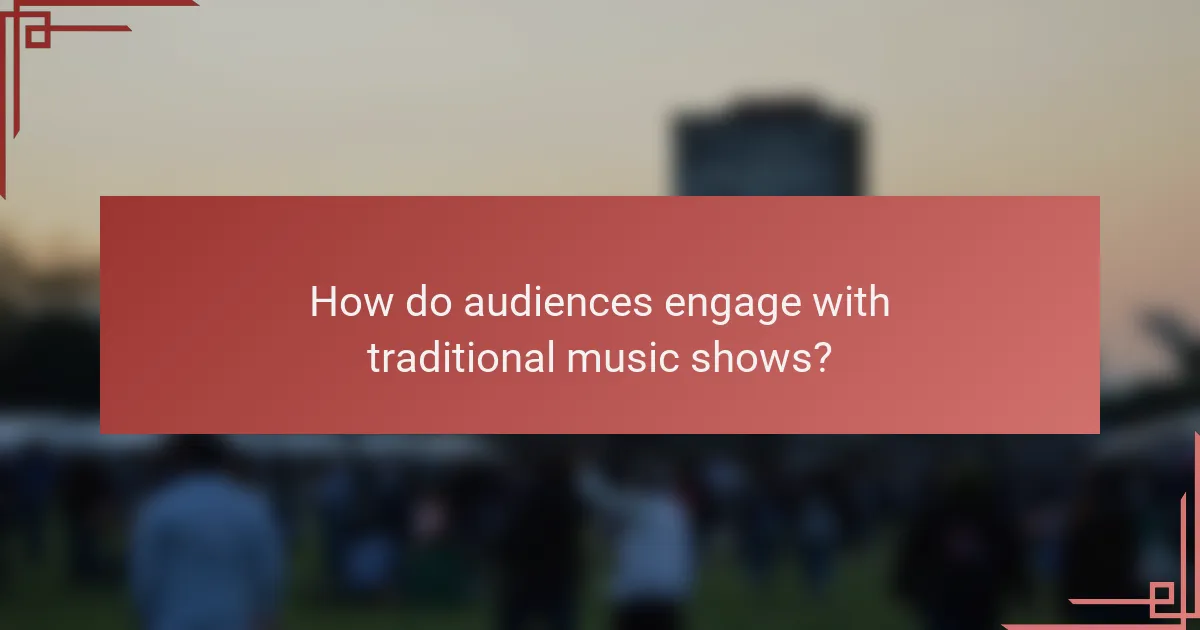
How do audiences engage with traditional music shows?
Audiences engage with traditional music shows through active participation, emotional connection, and community involvement. This engagement can enhance the overall experience, fostering a deeper appreciation for the cultural significance of the performances.
Audience participation methods
Audience participation in traditional music shows often includes clapping, singing along, and even dancing. These methods create a lively atmosphere and encourage performers to interact with the crowd, enhancing the overall experience.
In some cultures, audiences may also engage through call-and-response techniques, where the performer prompts the audience to respond at specific moments. This interaction not only entertains but also reinforces cultural traditions and community bonds.
Impact of social media on engagement
Social media has transformed how audiences engage with traditional music shows by allowing for real-time sharing and interaction. Platforms like Instagram and Facebook enable fans to post videos and photos, creating a virtual community around the event.
Additionally, artists can use social media to promote their shows, connect with fans, and receive immediate feedback. This two-way communication enhances audience involvement and can lead to increased attendance at live performances.
Community events and festivals
Community events and festivals play a crucial role in engaging audiences with traditional music. These gatherings often feature multiple performances, workshops, and interactive activities, allowing attendees to immerse themselves in the culture.
Such events foster a sense of belonging and pride within the community, as they celebrate local heritage and traditions. They also provide opportunities for networking among artists and audiences, strengthening cultural ties and encouraging future participation in traditional music shows.
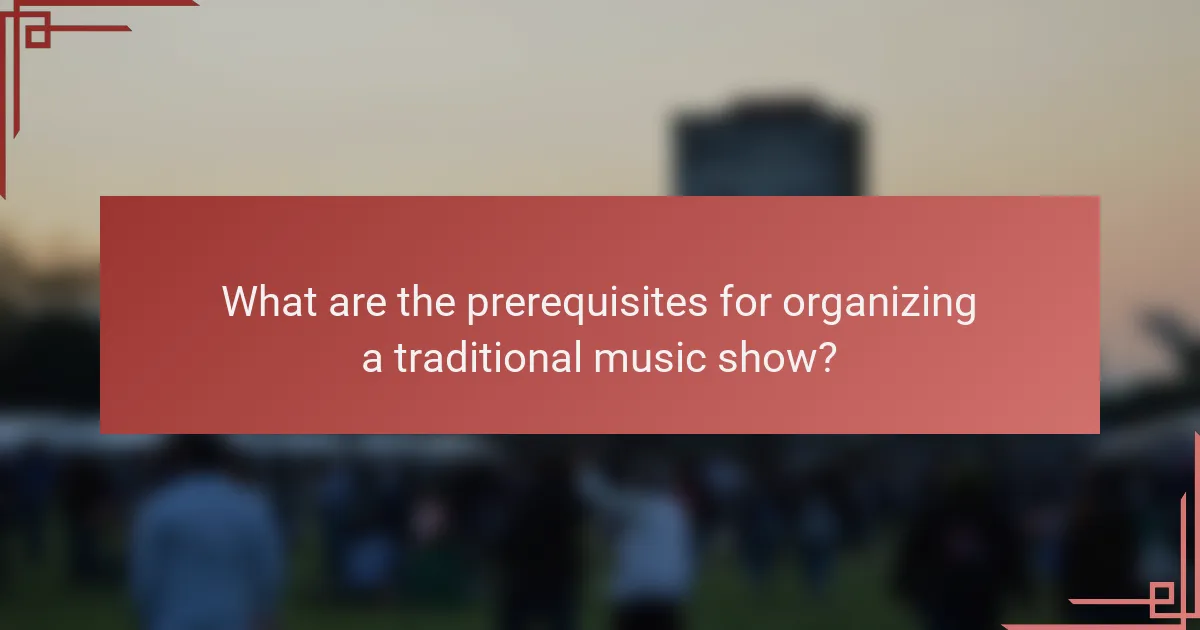
What are the prerequisites for organizing a traditional music show?
To organize a traditional music show, you need to consider venue selection, artist collaboration, and necessary licensing. Each of these elements plays a crucial role in ensuring a successful event that resonates with the audience and adheres to local regulations.
Venue selection criteria
Choosing the right venue is essential for a traditional music show. Consider factors such as capacity, acoustics, accessibility, and cultural significance. A venue that reflects the cultural heritage of the music can enhance the audience’s experience.
Additionally, evaluate the location’s logistical aspects, including parking availability, public transport access, and amenities for performers. Popular venues may require booking months in advance, so plan accordingly.
Artist collaboration requirements
Collaboration with artists is vital for a successful traditional music show. Identify musicians who specialize in the specific genre you wish to showcase, ensuring they have a strong understanding of the cultural nuances involved. This may involve reaching out to local artists or established performers who have experience in traditional music.
Establish clear agreements regarding performance fees, rehearsal schedules, and promotional responsibilities. Consider holding auditions or workshops to foster collaboration and ensure a cohesive performance.
Licensing and permits
Obtaining the necessary licenses and permits is a critical step in organizing a traditional music show. Check local regulations regarding performance rights, noise ordinances, and public assembly permits. These requirements can vary significantly by location, so it’s essential to research the specific laws in your area.
In some cases, you may need to secure rights from music licensing organizations to legally perform certain traditional pieces. Start this process early to avoid last-minute complications that could jeopardize your event.
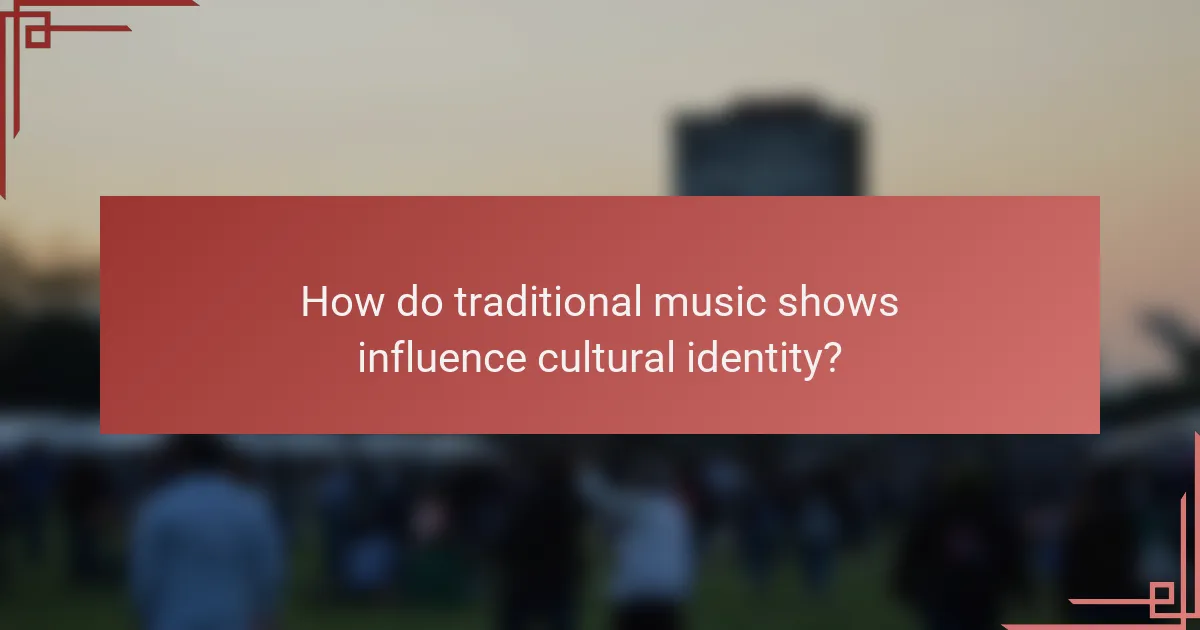
How do traditional music shows influence cultural identity?
Traditional music shows play a crucial role in shaping and expressing cultural identity by showcasing unique musical styles and practices. They foster a sense of belonging and continuity within communities, allowing individuals to connect with their heritage and share it with others.
Preservation of cultural heritage
Traditional music shows serve as vital platforms for preserving cultural heritage by keeping age-old musical traditions alive. These performances often feature authentic instruments, songs, and dances that reflect the history and values of a community.
For example, festivals celebrating folk music can include workshops where attendees learn traditional songs and instruments, ensuring that these practices are passed down to future generations. This active engagement helps maintain cultural narratives and practices that might otherwise fade away.
Promotion of local artists
Local artists benefit significantly from traditional music shows, which provide them with opportunities to showcase their talents and gain recognition. These events often feature a diverse lineup of performers, allowing emerging musicians to connect with audiences and industry professionals.
By promoting local artists, traditional music shows help to create a vibrant cultural scene, encouraging collaboration and innovation within the community. This not only boosts the artists’ careers but also enriches the local music landscape.
Impact on tourism and economy
Traditional music shows can have a substantial impact on local tourism and the economy by attracting visitors interested in cultural experiences. Events such as music festivals or cultural fairs draw tourists, which can lead to increased spending in local businesses, including hotels, restaurants, and shops.
For instance, a well-promoted traditional music festival can bring in thousands of visitors, significantly benefiting the local economy. Communities often see a boost in revenue during these events, making them essential for economic sustainability and cultural promotion.

